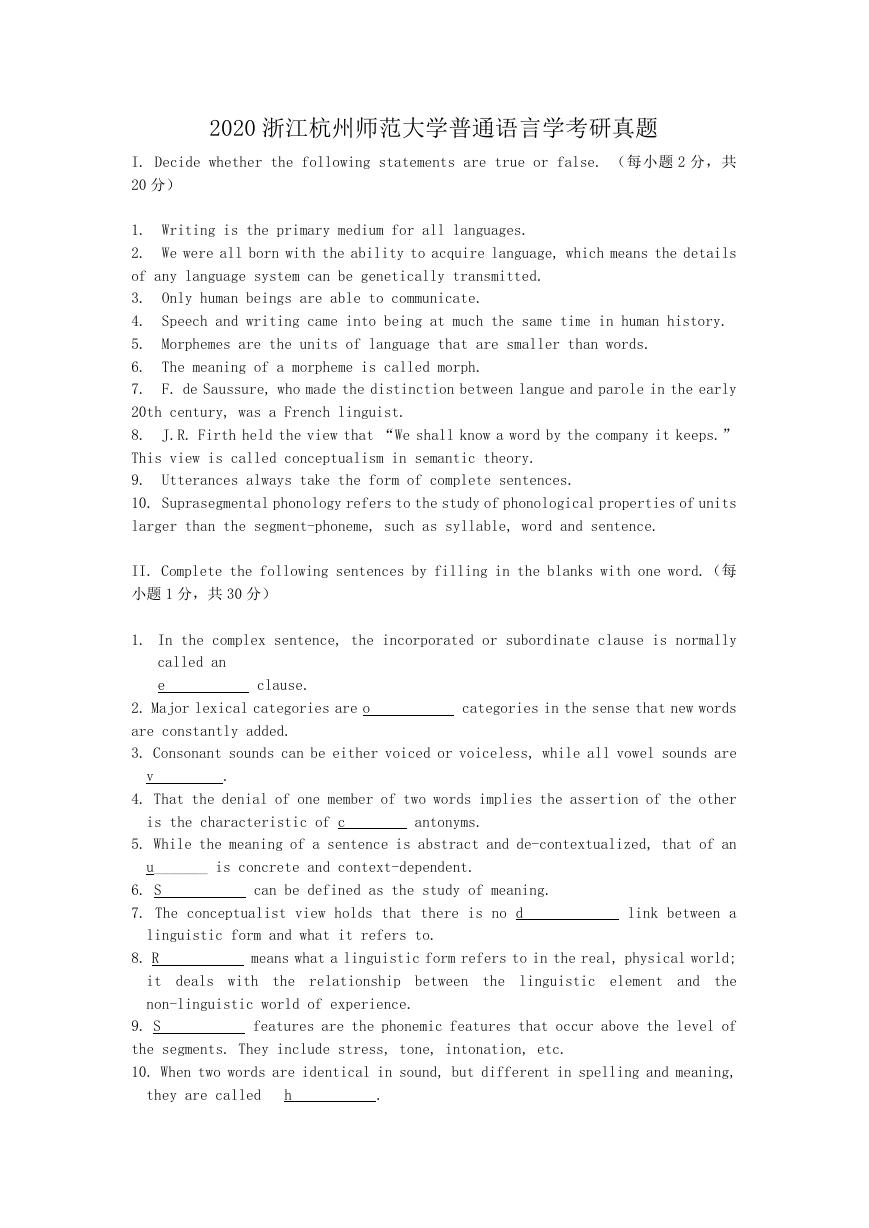2020 浙江杭州师范大学普通语言学考研真题
I. Decide whether the following statements are true or false. (每小题 2 分,共
20 分)
Writing is the primary medium for all languages.
We were all born with the ability to acquire language, which means the details
Only human beings are able to communicate.
Speech and writing came into being at much the same time in human history.
Morphemes are the units of language that are smaller than words.
The meaning of a morpheme is called morph.
F. de Saussure, who made the distinction between langue and parole in the early
1.
2.
of any language system can be genetically transmitted.
3.
4.
5.
6.
7.
20th century, was a French linguist.
8.
This view is called conceptualism in semantic theory.
9.
10. Suprasegmental phonology refers to the study of phonological properties of units
larger than the segment-phoneme, such as syllable, word and sentence.
J.R. Firth held the view that “We shall know a word by the company it keeps.”
Utterances always take the form of complete sentences.
II. Complete the following sentences by filling in the blanks with one word.(每
小题 1 分,共 30 分)
1. In the complex sentence, the incorporated or subordinate clause is normally
called an
e
clause.
2. Major lexical categories are o
are constantly added.
3. Consonant sounds can be either voiced or voiceless, while all vowel sounds are
categories in the sense that new words
v
.
4. That the denial of one member of two words implies the assertion of the other
is the characteristic of c
antonyms.
5. While the meaning of a sentence is abstract and de-contextualized, that of an
u_______ is concrete and context-dependent.
6. S
7. The conceptualist view holds that there is no d
can be defined as the study of meaning.
linguistic form and what it refers to.
link between a
8. R
means what a linguistic form refers to in the real, physical world;
it deals with the relationship between the linguistic element and the
non-linguistic world of experience.
features are the phonemic features that occur above the level of
9. S
the segments. They include stress, tone, intonation, etc.
10. When two words are identical in sound, but different in spelling and meaning,
they are called
h
.
�
11. R
opposites are pairs of words that exhibit the reversal of a
relationship between the two items.
12. C
analysis is based upon the belief that the meaning of a word can
be divided into meaning components.
13. Whether a sentence is semantically meaningful is governed by rules called s
restrictions, which are constraints on what lexical items can go with what others.
is a logical participant in a predication, largely identical
14. An a
with the nominal element(s) in a sentence.
15. According to the n
theory of meaning, the words in a language are
taken to be labels of the objects they stand for.
16. What essentially distinguishes s
and pragmatics is whether in the
study of meaning the context of use is considered.
17. The notion of c
is essential to the pragmatic study of language.
18. If we think of a sentence as what people actually utter in the course of
communication, it becomes an u
.
19. In any language words can be used in new ways to mean new things and can be combined
into innumerable sentences based on limited rules. This feature is usually termed
p
.
20. C
verifiable.
21. P
were statements that either state or describe, and were thus
were sentences that did not state a fact or describe a state, and
were not verifiable.
22. A c
23. An e
24. A c
is to commit the speaker himself to some future course of action.
is to express feelings or attitude towards an existing state.
sentence contains two clauses joined by a linking word, such as
"and", "but", "or".
25. In making conversation, the general principle that all participants are expected
to observe is called the C
Principle proposed by J. Grice.
26. Chomsky defines “competence” as the ideal user’s k
of his language.
27. Langue refers to the a
linguistic system shared by all the members
of a speech community while the parole is the concrete use of the conventions and
application of the rules.
of the rules
28. D
is one of the design features of human language which refers to
the phenomenon that language consists of two levels: a lower level of meaningless
individual sounds and a higher level of meaningful units.
29. A s
the predicate.
30. The discipline that studies the rules governing the formation of words into
may be a noun or a noun phrase in a sentence that usually precedes
permissible sentences in languages is called s
.
III. Explain the following terms. (每小题 4 分,共 40 分)
1. sociolinguistics
�
2. arbitrariness
3. displacement
4. performance
5. allophone
6. affix
7. D-structure
8. sense
9. predication
10. pragmatics
IV. Short answer questions. (每小题 15 分,共 60 分)
1. What characteristics of language do you think should be included in a good,
comprehensive definition of language?
2. How are the English consonants differentiated?
3. What is indirect language use? How is it explained in the light of speech act
theory?
4. In what ways are these expressions structurally ambiguous?
(a) We met an English history teacher.
(b) Flying planes can be dangerous.
�






 2023年江西萍乡中考道德与法治真题及答案.doc
2023年江西萍乡中考道德与法治真题及答案.doc 2012年重庆南川中考生物真题及答案.doc
2012年重庆南川中考生物真题及答案.doc 2013年江西师范大学地理学综合及文艺理论基础考研真题.doc
2013年江西师范大学地理学综合及文艺理论基础考研真题.doc 2020年四川甘孜小升初语文真题及答案I卷.doc
2020年四川甘孜小升初语文真题及答案I卷.doc 2020年注册岩土工程师专业基础考试真题及答案.doc
2020年注册岩土工程师专业基础考试真题及答案.doc 2023-2024学年福建省厦门市九年级上学期数学月考试题及答案.doc
2023-2024学年福建省厦门市九年级上学期数学月考试题及答案.doc 2021-2022学年辽宁省沈阳市大东区九年级上学期语文期末试题及答案.doc
2021-2022学年辽宁省沈阳市大东区九年级上学期语文期末试题及答案.doc 2022-2023学年北京东城区初三第一学期物理期末试卷及答案.doc
2022-2023学年北京东城区初三第一学期物理期末试卷及答案.doc 2018上半年江西教师资格初中地理学科知识与教学能力真题及答案.doc
2018上半年江西教师资格初中地理学科知识与教学能力真题及答案.doc 2012年河北国家公务员申论考试真题及答案-省级.doc
2012年河北国家公务员申论考试真题及答案-省级.doc 2020-2021学年江苏省扬州市江都区邵樊片九年级上学期数学第一次质量检测试题及答案.doc
2020-2021学年江苏省扬州市江都区邵樊片九年级上学期数学第一次质量检测试题及答案.doc 2022下半年黑龙江教师资格证中学综合素质真题及答案.doc
2022下半年黑龙江教师资格证中学综合素质真题及答案.doc